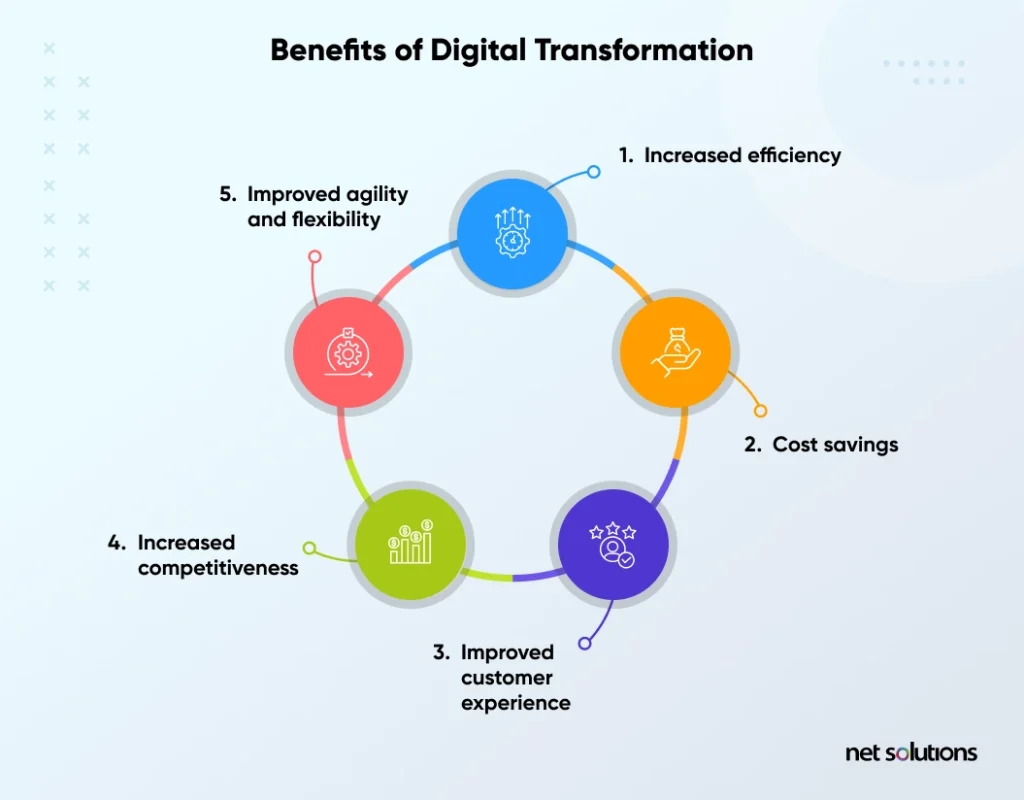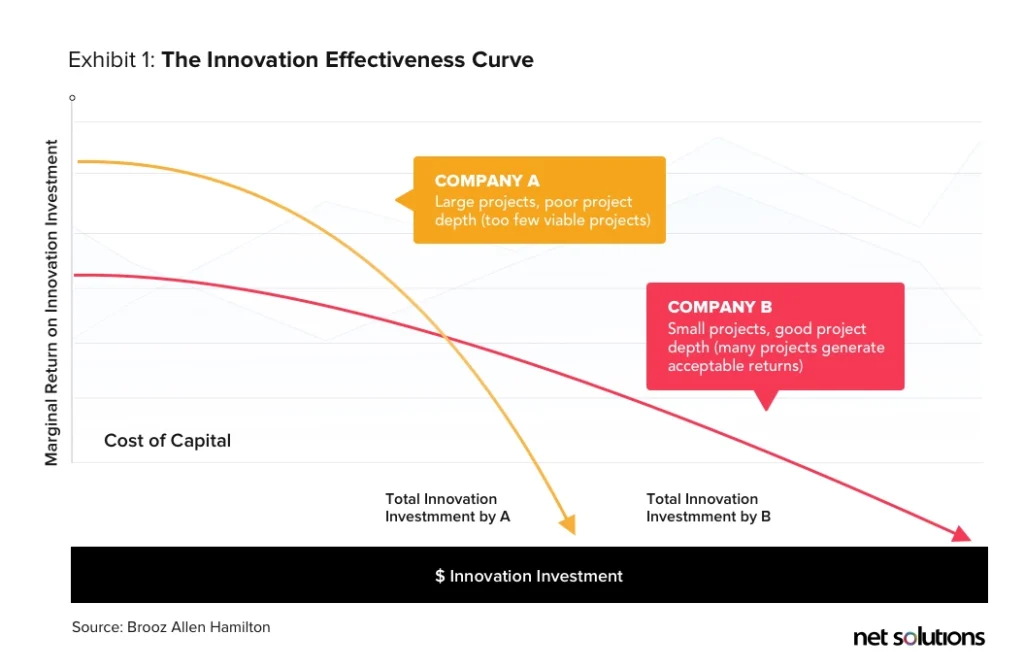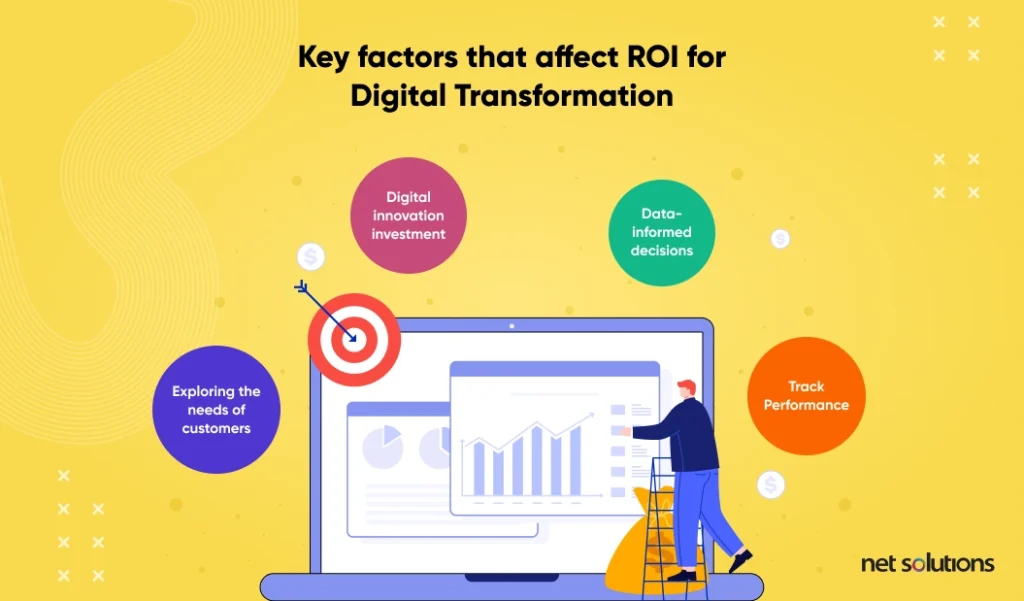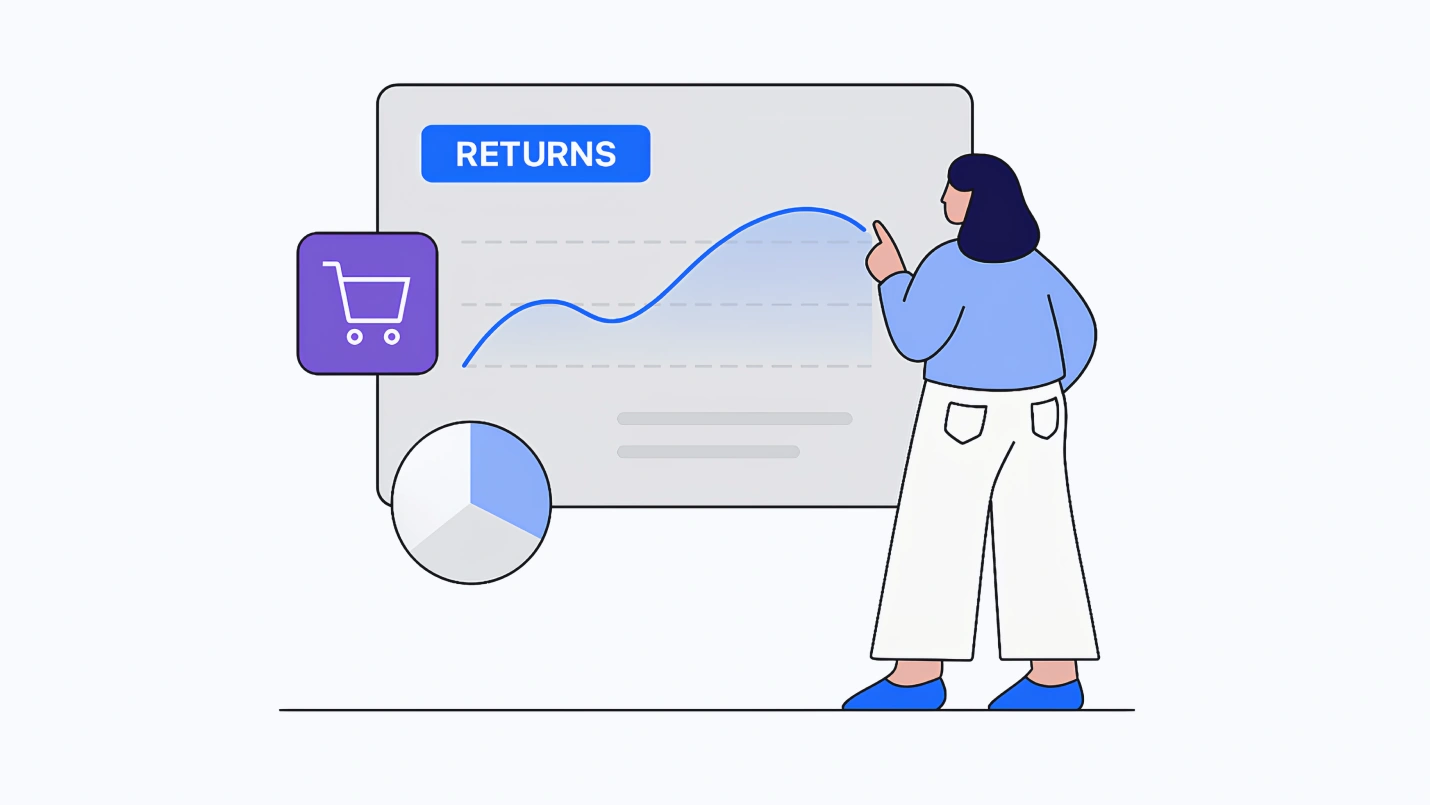Summary: Digital transformation can bring numerous benefits to a business, including increased efficiency, cost savings, and improved customer experience. This blog discusses the various benefits of digital transformation and how you can use ROI to measure the success of your digital transformation initiatives. By understanding ROI, you can make informed decisions about your digital investments and ensure they deliver value to your business.
Digital transformation has been a buzzword on everyone’s lips for the past few years, and a good reason. By leveraging digital technologies, businesses can streamline their operations, improve the customer experience, and gain a competitive edge in the marketplace.
But how can you tell if your digital transformation efforts are paying off?
That’s where the return on investment (ROI) comes in.
In this blog, we’ll explore what ROI is, why it’s essential, and how you can use it to measure the success of your digital transformation initiatives. So if you’re ready to find out if your digital investments are worth the effort, read on!

We respect your privacy. Your information is safe.
What is ROI, and why is it important?
Imagine you own a bakery, and you’re considering investing in a new oven that will allow you to bake twice as many pastries in the same amount of time. You do some research and find that the oven costs $10,000. You also estimate that, with the new oven, you’ll be able to sell an additional $20,000 worth of pastries each year.
To calculate the ROI of this investment, you would divide the gain from the investment ($20,000) by the cost of the investment ($10,000) and then multiply by 100 to express the result as a percentage. This would give you an ROI of 200%.
In this example, the ROI tells you that the new oven will pay for itself in just over 5 months (1 year / 200% = 0.5 years) and will continue to generate profit for the bakery for as long as it is in use. This can help you decide whether the investment is worth pursuing based on how much return you expect to receive on your investment.
So, what’s the takeaway here?
Return on Investment (ROI) is a financial measure that evaluates the efficiency of an investment or project. It is calculated by dividing the gain from the investment by the cost of the investment. The result is depicted as a percentage or a ratio.
ROI is important because it helps businesses determine whether an investment or project is worth pursuing. It allows them to compare the potential return of different investments and make informed decisions about allocating their resources.
Understanding Costs of Digital Transformation ROI.
Read MoreDigital transformation refers to using digital technologies to fundamentally change how an organization operates and delivers value to its customers. It can involve various activities, such as automating processes, digitizing products or services, and leveraging data analytics.
Some of the benefits of digital transformation include the following:

- Increased efficiency: By automating manual processes and leveraging data analytics, businesses can streamline their operations and reduce the time and resources required to complete tasks.
- Cost savings: Digital technologies can help businesses reduce costs by eliminating the need for certain physical infrastructure or manual labor and enabling them to target and serve their customers more effectively.
- Improved customer experience: Digital transformation can improve the customer experience by making it easier for customers to access products or services and providing relevant and personalized experiences.
- Increased competitiveness: By adopting digital technologies, businesses can differentiate themselves from their competitors and gain a competitive advantage in the marketplace.
- Improved agility and flexibility: Digital technologies can help businesses adapt to changing market conditions and customer needs more quickly and effectively.
Identifying digital transformation’s return on investment (ROI) can be challenging for transformation leaders. 69% of leaders who participated in a survey believe that measuring the return on digital transformation is difficult because customer interactions cannot be quantified using traditional means. Digital transformation cannot be measured using a single metric. Businesses need to evaluate their businesses as a whole and recognize the improvements in user experience, business processes, and workflow.
Worldwide spending on the technologies and services that enable the digital transformation (DX) of business practices, products, and organizations is forecast to reach $2.3 trillion in 2023, according to a new update to the International Data Corporation (IDC) Worldwide Semiannual Digital Transformation Spending Guide.
Digital Transformation Metrics
Businesses are attempting a more compelling and disruptive way of approaching digital transformation. A combination of all of the following metrics can help gauge the transformation:
- Increase in sales
- Increase in new customers, customer retention, and customer satisfaction
- Process quality improvement
- Product quality improvement
- Enhanced engineering productivity and design
- Digital adoption
- Reliability and availability of resources
One of the biggest success stories is that of Netflix. The company started as a DVD distributor and made its way to become the top digital on-demand content rental service in the world. Netflix focused on offering the three most important things that drive digital transformation – customer experience, digital capability, and returns on innovation.
1. Customer Experience

Digital transformation has the potential to impact all aspects of a business, but customer experience is where it has the biggest influence. With all of the advances in digital transformation trends that we have seen, customer experience takes top priority for businesses that are successful via digital platforms.
With these platforms allowing customers to interact directly with brands, it is important to assess the benefits of using new technology to improve customer experience. Keep an eye out for technological innovations becoming the driving force in improving customer experience, and try to implement the best digital marketing strategies to improve customer experience.
Automation is one of the most important digital innovations, with 84% of customers stating the importance of computer-based apps for communicating with brands. The value of your digital transformation efforts for your customers matters more than short-term revenues. Brand value can also be affected by organizational efforts that directly affect customers. For example, good data security practices can incite trust in your customers if you maintain a clean record of preserving and keeping your customer’s data safe.
2. Digital Capability
Seven important capabilities drive digital transformation, according to a report by Deloitte. Some important ones include intelligent workflows, business model adaptability, and unified customer experience. It is also essential to have a business ecosystem that relies on partnering with external businesses to offer the best in technology and leverage their talent and resources to drive digital transformation.
Intelligent workflows allow you to maximize your technology and human resources capabilities. Businesses need to build an environment that allows the best business outcomes using intelligent workflows. A unified customer experience should focus on delivering the most efficient and seamless products and services.
With digital transformation reshaping businesses constantly, it is important to allocate revenues used by your business to improve the digital capabilities of your business. You should be able to adapt your business model to the latest technological innovations and tweak revenue streams catering to digital innovation.
3. Returns on Innovation
Digital innovation strategies matter more than investment size when measuring digital transformation. At the basic level, innovation is determined by a product or service that offers something new. This could be a brand-new digital product or an existing product that introduces a digital approach to make the customer experience easier. Incremental investments are more likely to lead to diminishing returns. Instead, you should focus on investing big into innovation and keep up with the latest technology trends to succeed as a business in the digital world.

Steps for calculating the ROI of digital transformation
Step 1: Identify the objectives of your digital transformation project
Before you can calculate the ROI of your digital transformation project, you need to define what you hope to achieve with it. This might include increasing revenue, improving customer satisfaction, or streamlining operations. By identifying the objectives of your project, you’ll have a clear target to aim for and be able to measure the results more accurately.
Step 2: Determine the costs of the project, including hardware, software, and labor costs
To calculate the ROI of your digital transformation project, you’ll need to know how much it costs. This includes the initial investment in hardware and software and ongoing costs such as maintenance and support. Additionally, you’ll need to consider the labor costs associated with implementing and maintaining the project, including the time and resources needed to train employees and manage the project. You can hire a digital transformation consultancy to manage your project efficiently.
Step 3: Identify the project’s benefits, including increased revenue, cost savings, and improved efficiency
Next, you’ll need to identify the benefits of your digital transformation project. This might include increased revenue from selling more products or services, cost savings from streamlining operations or reducing physical infrastructure, and improved efficiency from automating processes or leveraging data analytics. By identifying and quantifying these benefits, you’ll be able to compare them to the project’s costs and calculate the ROI.
Key Factors that Affect ROI for Digital Transformation

The ROI of digital transformation is easy to measure if you have a well-established product. If you are breaking into a new market with an innovative product, you must focus on identifying customer satisfaction trends and positive changes to your product or service quality. For established businesses, the ROI of digital transformation is usually static. But when new technology is introduced in an organization, the possibility of digital growth is high.
Marketing timing is critical for new products, which can lead to long-term and elastic ROI. Getting a head start over your competitors when pushing out an innovative product or service is important. The best way to identify the ROI for your digital innovation efforts is to focus on your digital transformation roadmap’s market value, total revenue, and year-over-year growth figures.
1. Exploring The Needs of Customers
As a digitally-driven business, you must create compelling digital experiences for your customers and strive to exceed their expectations. This can be achieved via social media interactions or by collecting customer data based on their interactions with your business.
2. Digital Innovation Investment
Businesses need to work on digitizing business processes to make customer experiences more engaging and improve workflow. Implementing new digital systems and tools is a must to promote a digital culture in the workplace.
3. Data-Informed Decisions
Customer data is one of the best sources of information to help you decide on your next digital transformation strategies. Past purchasing behavior, customer reviews and feedback, and sales figures are the best metrics to form data-informed decisions.
4. Track Performance
You need to constantly prototype, test, and promote a digital culture that is tracked. Your digital transformation efforts must translate to better sales, revenue, and customer satisfaction. The speed at which you adopt new technology for your business affects your effectiveness in digital transformation.
Tips for maximizing the ROI of digital transformation
- Set clear goals and objectives for your digital transformation project
- Involve all relevant stakeholders in the planning and execution of the project
- Regularly track and measure the progress of the project to ensure it is on track to meet its goals
- Leverage data and analytics to optimize the project and make informed decisions about its direction
- Create your ROI model ahead of time
- Make sure you analyze technologies skillfully.
Frequently Asked Questions
KPIs, or Key Performance Indicators, are metrics that are used to measure the success of a project or initiative. Some common KPIs for digital transformation include:
- Return on Investment (ROI)
- Customer Satisfaction
- Revenue Growth
- Cost Savings
- Time to Market
- Conversion Rates
- Website Traffic
- Social Media Engagement
The three key aspects of digital transformation are –
- Technology: Digital transformation involves the adoption and integration of digital technologies, such as cloud computing, data analytics, and artificial intelligence.
- Culture: Digital transformation requires a shift in mindset and a willingness to embrace change and innovation. This requires a culture that supports and encourages these values.
- Processes: Digital transformation involves rethinking and redesigning business processes to take advantage of digital technologies and improve efficiency and effectiveness.
Digital transformation can impact various aspects of a business. Still, four main areas are typically focused on:
- Customer Experience: Digital transformation can help businesses create more personalized and convenient customer experiences.
- Operations: Digital technologies can streamline and automate business processes, improving efficiency and reducing costs.
- Products and services: Digital transformation can involve digitizing products or services or creating new digital offerings.
- Business models: Digital transformation can enable businesses to create new revenue streams or disrupt traditional business models.
There are many ways to approach digital strategy. Still, one common framework includes three layers:
- Foundational layer: This includes the underlying infrastructure, such as IT systems and data management, that enables digital transformation.
- Enabling layer: This includes the technologies, processes, and capabilities that enable businesses to deliver value to customers in a digital environment.
- Differentiating layer: This includes the unique features or capabilities that set a business apart from its competitors and drive customer loyalty and engagement.




